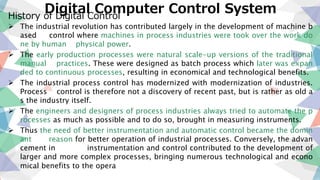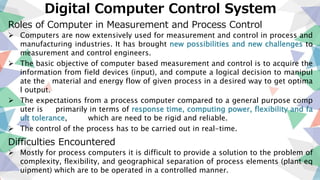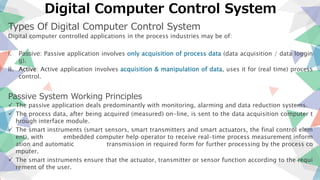Introduction to Digital Computer Control System
- 1. Introduction to Control System Introduction to Digital Computer Control Reference Introduction to Computer Based Control System IDC Technology
- 2. Digital Computer Control SystemHistory of Digital Control The industrial revolution has contributed largely in the development of machine b ased control where machines in process industries were took over the work do ne by human physical power. The early production processes were natural scale-up versions of the traditional manual practices. These were designed as batch process which later was expan ded to continuous processes, resulting in economical and technological benefits. The industrial process control has modernized with modernization of industries. Process control is therefore not a discovery of recent past, but is rather as old a s the industry itself. The engineers and designers of process industries always tried to automate the p rocesses as much as possible and to do so, brought in measuring instruments. Thus the need of better instrumentation and automatic control became the domin ant reason for better operation of industrial processes. Conversely, the advan cement in instrumentation and control contributed to the development of larger and more complex processes, bringing numerous technological and econo mical benefits to the opera
- 3. Digital Computer Control System History of Digital Control The earliest recorded suggestions for use of computer for measurement and control (in real-time) a pplication were made by Brown and Campbell in their paper in 1950. In this specific reporting the c omputer was used in both feedback and feed-forward loops. Scientists also suggested using digital computing elements (logics) for setting up the control functions. The first digital computer developed specifically for control (in real-time application) was for airbor ne (military) operation, and in 1954 a digital computer was successfully used to provide an automa tic flight and weapons control system. Late 1950s itself saw the application of digital computers in industrial measurement & control for t he purpose of process control. The first industrial computer control system, called RW – 300 system (of Ramo-Wooldridge Company) was installed at Port Arthur refinery of Texaco Company in T exas. This system was capable of providing closed-loop control. The RW-300 systems were later installed by a number of chemical industries during early 1960s t o work as supervisory control systems. The logged information was used for steady-state opti mization calculations to determine the set-points for standard analog controllers. These computers based systems were only indicative type; that means these did not control directly the movement o f the valves or other final control elements. The first direct-digital control (DDC) computer system developed and operated for process mon itoring and control was Ferranti Argus 200; a large system with a provision of 120 control loops and 256 measurement inputs. The architecture of this computer system has ferrite core memory sto rage system (it replaced the rotating drum as used by the RW – 300 computers).
- 4. Digital Computer Control System Roles of Computer in Measurement and Process Control Computers are now extensively used for measurement and control in process and manufacturing industries. It has brought new possibilities and new challenges to measurement and control engineers. The basic objective of computer based measurement and control is to acquire the information from field devices (input), and compute a logical decision to manipul ate the material and energy flow of given process in a desired way to get optima l output. The expectations from a process computer compared to a general purpose comp uter is primarily in terms of response time, computing power, flexibility and fa ult tolerance, which are need to be rigid and reliable. The control of the process has to be carried out in real-time. Difficulties Encountered Mostly for process computers it is difficult to provide a solution to the problem of complexity, flexibility, and geographical separation of process elements (plant eq uipment) which are to be operated in a controlled manner.
- 5. Digital Computer Control System Types Of Digital Computer Control System Digital computer controlled applications in the process industries may be of: i. Passive: Passive application involves only acquisition of process data (data acquisition / data loggin g). ii. Active: Active application involves acquisition & manipulation of data, uses it for (real time) process control. Passive System Working Principles The passive application deals predominantly with monitoring, alarming and data reduction systems. The process data, after being acquired (measured) on-line, is sent to the data acquisition computer t hrough interface module. The smart instruments (smart sensors, smart transmitters and smart actuators, the final control elem ent), with embedded computer help operator to receive real-time process measurement inform ation and automatic transmission in required form for further processing by the process co mputer. The smart instruments ensure that the actuator, transmitter or sensor function according to the requi rement of the user.
- 6. Digital Computer Control System Applications The major application of digital computers is in process control and plant optimization. Computer control systems, once prohibitively expensive, can now be tailored to fit most industrial ap plications on a competitive economic basis (cheap implementation). The advances in the use of computer control have motivated many and changed the concepts of the operations of industrial processes. Video display terminals now provide the focus for operators to su pervise the whole plant from a control room. Large panel of instruments, knobs and switches are replaced by a few keyboards and screens. Contro l rooms are now much smaller and fewer people are required to supervise the plant. Process control computers now have the capability to implement sophisticated mathematical models. Plant managers and engineers can be provided with comprehensive information concerning the statu s of plant operations to aid effective operation. With the use of microprocessor-based instruments and new emerging techniques, it is possible for a utomatic tuning of controller parameters for best operating performance. The expert systems and advanced control techniques such as model based predictive control, are bei ng applied with the help of computers for optimization of the process operation.
- 7. Digital Computer Control System Basic components and Block Diagram of Computer Control System The basic components are: 1. Sensor : Measurement and Data Acquisition 2. Comparator : Data conversion and scaling and checking 3. Analog to Digital Converter : Data accumulation and formatting, visual display 4. Computing Algorithm : Comparing with limits and alarm raising Events, sequence and trends; monitoring and logging 1. Digital to Analog Converter : Data logging and Computation 2. Plant : Control actions
- 8. Digital Computer Control System Figure: Block Diagram Of Computer Based Process Control System The controlled variable (o/p of the process) is measured as continuous electrical signal (analog ), and converted into a discrete-time signal using a device called Analog-to-digital-conver ter (ADC). This digital signal is fed back to a comparator (digital) and compared with the discrete form of set point, which is the desired value, by the digital computer; this produces an error signal e. An appropriate computer program representing the controller, called control algorithm, is exe cuted which yields a discrete controller output. The discrete signal is then converted into a continuous electrical signal using a device called Digital to-analog-converter (DAC). The analog signal is fed to the final control element. This control strategy is repeated at some predetermined frequency (time division multiplexed with other control loops and other associated activities) to achieve closed-loop computer cont
- 9. Digital Computer Control System Architecture of Computer based Process Control System Computer-aided Industrial Process can be classified on the basis of their architecture under o ne or more of the following: i. Centralized Computer Control Comprised of large computer system with huge space and power consuming type magnetic core memory. Mostly done to improve the speed of operation. System is expensive due to high cost of core memory and additional electronics. Use of centralized computer control systems also had problems of providing expe nsive communication systems for bringing in the (field) signals to the centrali zed computer location; and output control signals to the field devices (valv es, motors, actuators etc.). Electrical noise problems for large distance communication of signals was a major cause of process interruptions. Due to sudden computer stoppages leading to complete stoppage of plant/proces s and, as a consequence, resulted in losses and poor quality products.
- 10. Digital Computer Control System ii. Distributed Computer Control With the advent of microprocessors and microcomputers, distributed computer control architecture became very popular because such systems were capable of tackling the problems and limitations of centralized computer control system were removed. The work of monitoring and control of the industrial processes is not divided by functions and allocated to a particular computer; instead, the total work is divided up and spread across several computers. Since industrial processes are geographically located over wide area, it is essential that the computing power required to control such processes be also distributed and more emphasis be put to locations where major (control) activity takes place. This limits the data flow to a single sink and instead ensures continuation of operation of the pl ant even if there are failures at some sub systems.
- 11. Digital Computer Control System iii. Hierarchical Computer Control There is hierarchy of computers connected on a network with each performing dist inct functions. In this type of control, the upper level computers depend on lo wer level devices for process data, and the lower level systems depend upon high er level systems for more sophisticated control functions such as overall plant o ptimization. Figure: Five levels of automation hierarchy of a (hierarchical) computer based process control system
- 12. Digital Computer Control System Task Listing of Computer Based System Field Level (Level-0) Measurement of process parameters, signal conditioning etc. if necessary, and transmissio n of field parameters to the control level (Level-1) computer control systems. Control Level (Level-1) Systems at this level maintain direct control of the plant units under their cognizance, dete ct emergency condition in these units and take appropriate action. Undertakes system coordination and reporting jobs by collecting information on unit prod uction, raw material consumption, and energy consumption; transmits to higher level co mputer (Level-2). Programming part of operator’s human machine interface (HMI) done at this level. Takes up reliability assurance activities by performing diagnostics on the various control e quipment; this also helps in detecting the faults and maintaining the standby system if con nected to the system.
- 13. Digital Computer Control System Supervisory Level (Level-2) This level enforces control on the system by responding to any emergency condition at its own level. Also optimizes processes under its control as per established production schedule and car ry out all established process operational schemes or operating practices for the proc esses. The coordination of the plant operation is taken up for here for data reporting; this level c ollects and maintain process/production database. The records for inventory and raw mate rial are maintained at this level; monitors on the energy consumption by units under its co ntrol. This level is where communication with higher and lower level computer systems are coord inated. The reliability assurance part of the job performs diagnostics on the various control equip ment to detect the fault and keep updating hot-backup (standby) system if connected in the hierarchy.
- 14. Digital Computer Control System Plant Level (Level-3) This level undertakes production planning and scheduling job by preparing immediate pro duction schedule under its area of control. The monitoring and recording of all the plant are done by computers at Level 3. The production cost optimization function is taken up by modifying the production schedu le based on inputs received from lower levels; the energy consumption and optimization o f energy use is manipulated at this level. The plant coordination and operational data reporting jobs which include preparing produc tion reports, maintenance of plant inventory about material and energy usage, maintaining communications with the higher and lower level computers, operation related data collecti on and off-line analysis for future prediction and usage. Services to the operator’s human machine interface (HMI) are taken up at this level. Under reliability assurance activities, the diagnostics on the various control equipment to help i n detecting the fault and keeping the standby system live is taken up at this level.
- 15. Digital Computer Control System Management level (Level-4) The core area of activity at this level involves management tasks. Under Sales and Marketing the activities taken up are customer order management, order booking, and transferring order information to plant level (Level – 3) computers. Market for ecasting and market intelligence, customer database management, market survey are the other activities of this level. Under finance and accounting the logging and monitoring of company’s sales and expendi tures, annual accounting, profit and loss account for the management information etc. are undertaken.
- 16. Digital Computer Control System Human Machine Interface Technically where the human and the machine may interact. It is the area of the human and the area of the machine that interact during a given task. In teraction can include touch, sight, sound, heat transference or any other physical or cognitive functi on. The goal of human-machine interaction engineering is to produce a user interface which makes it easy, efficient, and enjoyable to operate a machine in the way which produces the desired result. HMI devices consist mainly of the following components: Display unit (CRT) Keyboard Input unit Printing unit Control Panel/desks, mimic board/panel Recorders
- 17. Digital Computer Control SystemArchitecture of general purpose computer The four basic components of a general computer are: Central Processing Unit (CPU) Main unit inside the computer/heart of the computer). It controls all internal and ex ternal devices, performs arithmetic and logic operations and consists of control unit, arithmetic logic unit (ALU), temporary (primary storage) and general purpo se registers. Storage section (memory)) Main function of storage device is to store data and instructions (programs). Input/ output (I/O) section Sub-system through which the CPU communicates with outside world. For commun ication between the CPU and human machine interface (HMI) and other peripheral devices s uch as printers, external storage, keyboards, mouse etc. Bus Interface Bus Interface is an electronic pathway (media) in computer based system that provi des a communication path for data to flow between the CPU and its memory and peripher als and amongst the CPUs connected to the computer system
- 18. Digital Computer Control System Analog Quantities: Thermocouples, strain gauges, flow meters, level sensors, etc. generate m easured outputs as analog quantities in the form of milivolts (mV) or miliamperes (mA). The mV or mA signals are amplified and fetched to the computer after converting these analog si gnals into digital signal. Digital Quantities: These are process events such as (on/off) operation of a limit switch, open or closed contacts, a valve( in open or closed position), a switch in power on or off position, a relay in open or closed condition, etc. These statuses (on/off, open/close) are sensed in form of digital quantities. These digital quantities can be either binary (0/1) or a Binary Coded Deci mal (BCD) or in other formats. Digital quantities are directly sent to the computer without any conversion. Pulses or pulse rates: These may be outputs (or inputs) of some measuring instruments such as flow meters, stepper motors as controllers, valves, a motor on or off, etc. Telemetry: This is a mechanism of transmitting a measured process quantities to a convenien t remote location or to multiple locations, in a form, suitable for displaying, recording or act uating a process.
- 19. Digital Computer Control SystemAnalog interfaces These interfaces take up the continuous (time varying) type analog inputs. The interfacing har dware ensures compatibility of the incoming (or outgoing) signals to and from digital com puter. The popular analog interfaces applied with digital computer are: Analog-to-digital converter (ADC): An analog-to-digital converter (abbreviated ADC, A/D or A to D) is a device that converts a continuous quantity to a discrete time digital representation. Digital-to-analog converter (DAC): Digital-to-analog conversion is a process in which signals having two defined levels or states (digital) are converted into analog signals (theoretically i nfinite number of states). Modem: This device transmits data between computers, workstations and other peripheral de vices interconnected by means of conventional communication lines supporting analog tr ansmission. Modem transforms (modulate) data from a digital device to an analog form which is suitable for transmission on (analog) lines. Since , in general, the data flows in both direction, modems are also able to receive an analog signal from some remote device and restore it back (by demodulation) to its original digital form.
- 20. Digital Computer Control System Multiplexing: It is a process of sending multiple signals/streams of information on a carrier at the same time in the form of a single, complex signal. At receiver end, the multiplexed signal is de-multiplexed to recover all the multiplexed signals. Ex: Space division multiplexing Frequency division multiplexing Time division multiplexing. Multiplexer: The circuit that combines signals at the source (transmitting) end of a communic ations link is known as a multiplexer. De-multiplexer: At the other end of the long-distance cable, the individual signals are separat ed out by means of a circuit called a de-multiplexer.
- 21. Digital Computer Control System Advantages of Using Digital Computer Control System Computers ensure the repeatability in the product quality that is essential in manufacturin g plants. It permits flexibility to modify the sequencing and control procedures to provide for the m anufacture of a different product and frequent changes in product specification. It maintains a data base containing the product recipe and thus is easy to change to a new recipe quickly and reliably. Use of computers increases the productivity of the plant significantly by ensuring greater p lant availability. It provides increased understanding of the behavior of the processes. It helps in reduction in dead time of batch operation.
























































































